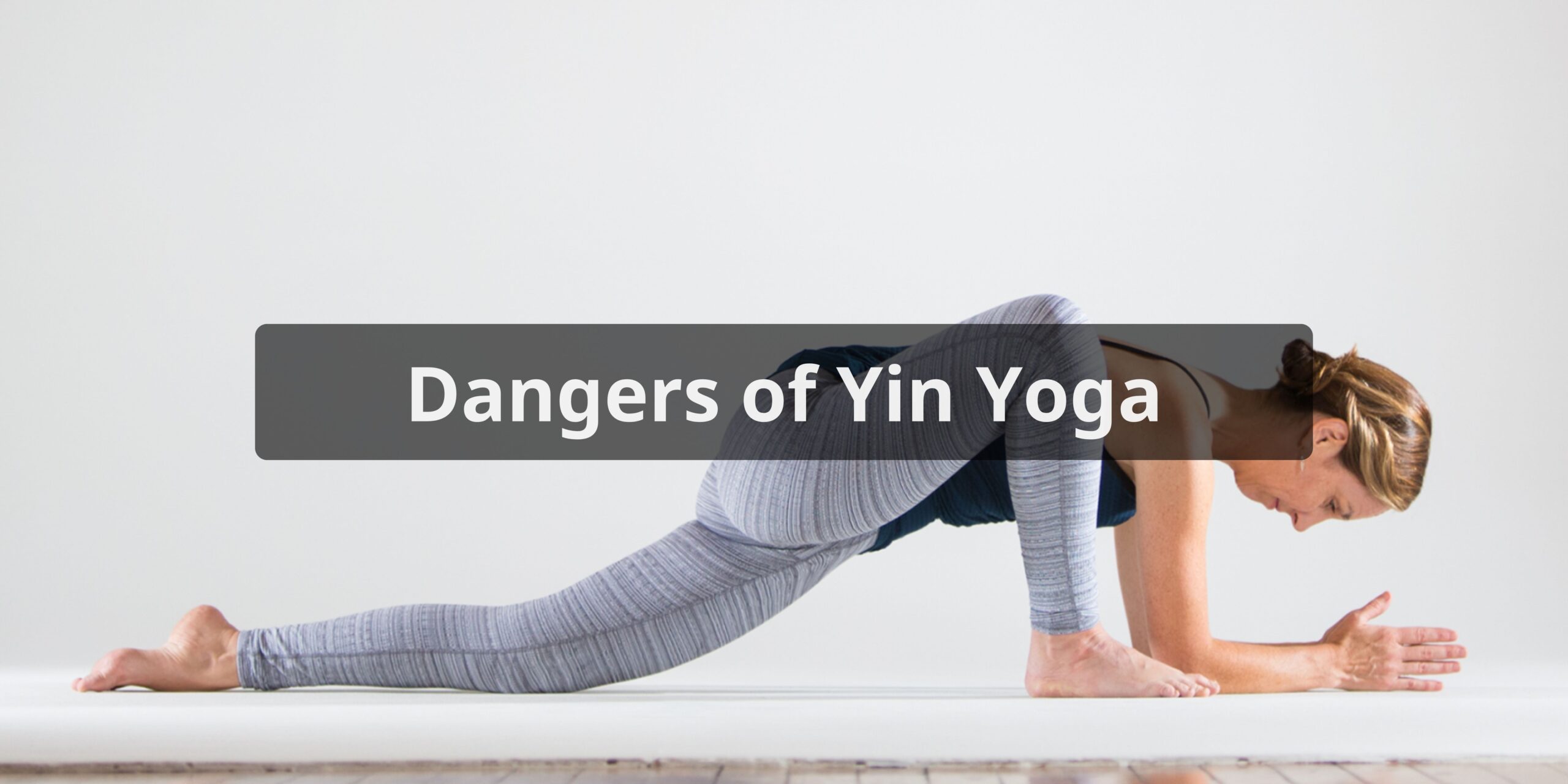Yin yoga has become an increasingly popular style of yoga in recent years. While it certainly has its benefits, there are some potential dangers of yin yoga that practitioners should be aware of. In this article, we’ll explore what yin yoga is, the benefits and risks, and tips for practicing it safely.
What is Yin Yoga?
Yin yoga is a slow-paced, meditative style of yoga that mainly focuses on holding seated and supine poses for long periods of time, typically 3-5 minutes or more. The poses target the body’s connective tissues, like the ligaments, joints, fascia, and bones, rather than the muscles.
The goal of yin yoga is to improve flexibility and access deeper layers of fascia and connective tissues. It also aims to cultivate awareness and stillness by holding poses for longer durations. Yin classes are usually performed at cooler temperatures and feature longer holds in poses with props like bolsters and blankets to facilitate deep release.
Benefits of Yin Yoga
There are several potential benefits associated with a regular yin yoga practice:
- Improves joint mobility and range of motion
- Lengthens connective tissues and fascia
- Stimulates ligaments, joints, and bones
- Calms the nervous system
- Promotes mindfulness and awareness
- Reduces stress and anxiety
- Encourages acceptance and surrender
For athletes, dancers, or those with Desk jobs, yin yoga can be an effective practice to counterbalance long hours of sitting or repetitive movements. The long holds gently stretch tight hips, hamstrings, and shoulders.
Risks and Dangers of Yin Yoga
While yin yoga certainly offers advantages, there are some potential dangers to be aware of if poses are held for too long or executed incorrectly. Some risks include:
Overstretching
Many yin poses involve flexion or deep forward folds, such as rabbit pose, saddle pose, or dragonfly pose. Holding these poses for extended periods can lead to overstretching muscles or connective tissues. Going too deep or staying too long in a pose could tear ligaments or tendons. It’s important to be mindful of your edge in these postures.
Compressing Joints
Certain yin poses such as frog pose, half butterfly, or sleeping swan involve folding the body into compressed postures. This places a lot of pressure on the knees, hips, spine, neck and shoulders. Holding compressed postures for a long time can strain joints like the menisci in the knees. Make sure to bring plenty of cushions and props to support joints in these shapes.
Injuring the Back or Spine

Poses like seal pose and melting heart pose require intense spinal flexion. Staying curled in a ball shape for several minutes can pinch nerves and strain the discs or vertebrae, especially for those with pre-existing back injuries. Ensure you have appropriate back support and exit any pose that causes pain.
Blood Flow Restriction
Some yin postures may limit circulation, especially in the hips, pelvis, and legs. Lying still for too long with knees bent or legs crossed can restrict blood flow. This could leave you feeling tingly or numb. Be mindful of any tingling sensations and adjust your pose as needed.
Falling Asleep
The quiet, meditative nature of yin yoga makes it easy to drift off to sleep, especially in supine poses! Though restorative, falling asleep in certain postures could lead to muscle strains or soreness. Try to remain awake and conscious during your practice.
Tips for Safe Yin Yoga Practice
There are several precautions you can take to practice yin yoga safely:
- Always warm up first with some gentle movement or active yoga postures before holding yin poses.
- Use plenty of props like blankets, bolsters, and blocks to support the body and prevent overstretching or joint strain.
- Start by holding poses for shorter durations, 1-2 minutes, and gradually increase hold times as the body adapts.
- Avoid compressing joints by using cushions or adjusting your range of motion.
- Be mindful of back support in forward folds.
- Release poses at the first sensation of strain or intense discomfort.
- Build strength to support joints in complementary practices like Pilates, weight training, or hatha yoga.
- If you have injuries or medical conditions, check with a doctor before practicing yin yoga.
- Practice in a warm room to keep muscles pliable.
- Stay hydrated and replenish electrolytes after class.
Conclusion
In conclusion, yin yoga offers many benefits but also comes with some precautions. It’s best suited for flexible individuals and athletes looking to balance their training with deep stretching. For beginners or those new to yoga, it’s wise to start slowly and avoid overexerting yourself in poses. With an experienced teacher’s guidance and the proper props, yin yoga can be adapted for all levels to be performed safely. The keys are listening to your body’s limits, using modifications, and building up hold times gradually. Practiced mindfully, yin yoga can lead to improved joint health and body awareness.
FAQs About Dangers of Yin Yoga
Can Yin Yoga poses lead to injuries or strain?
Yes, Yin Yoga poses can lead to injuries or strain if not practiced mindfully. Prolonged holds might stress tissues, and pushing beyond your limits can result in strains. Proper alignment, gradual progression, and listening to your body are crucial.
What are some common mistakes that can lead to injuries in Yin Yoga?
Common mistakes include forcing poses, ignoring discomfort, and not using props when needed. Rapid or excessive deepening of stretches can strain muscles or ligaments, leading to injuries.
Can Yin Yoga exacerbate existing injuries or conditions?
Yes, it’s possible. While Yin Yoga can aid recovery, inappropriate poses might worsen existing injuries. Practitioners with injuries or medical conditions should consult professionals and modify poses accordingly.
Are there specific populations that should approach Yin Yoga with caution?
Individuals with joint issues, injuries, or certain medical conditions should approach Yin Yoga cautiously. Pregnant women and those with osteoporosis or hypermobility should also consult professionals before practicing Yin Yoga.
How does the prolonged holding of poses in Yin Yoga contribute to potential risks?
Prolonged holds can strain tissues, especially if alignment is incorrect. The gradual intensity of Yin Yoga can sometimes lead to an overstretching of connective tissues, leading to discomfort or injury.
Can Yin Yoga lead to overstretching or hypermobility?
Yes, improper practice can contribute to overstretching, especially for individuals who are naturally hypermobile. Striving for flexibility without stability might lead to joint instability and hypermobility-related issues.
How does Yin Yoga affect joints, and are there joint-related risks?
Yin Yoga targets deep connective tissues around joints. If not practiced with care, it could stress joints and exacerbate joint-related conditions. Proper alignment, using props, and respecting individual limits are vital.
Is it necessary to have guidance from a qualified instructor to minimize risks?
Yes, having guidance from a qualified Yin Yoga instructor is recommended, especially for beginners and those with medical considerations. Instructors can offer personalized guidance, alignment cues, and modifications to prevent risks.
What precautions can practitioners take to enjoy the benefits of Yin Yoga safely?
Practitioners should honor their bodies, avoid pushing beyond their edge, and use props for support. Gradually increasing pose duration, respecting individual limits, and seeking guidance from professionals when needed are crucial for safe practice.

